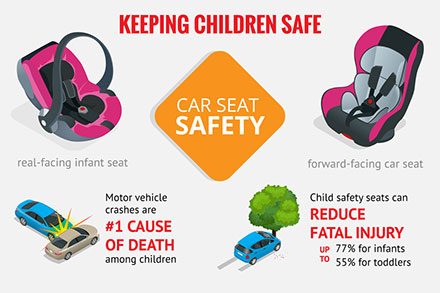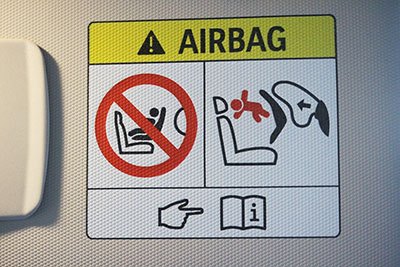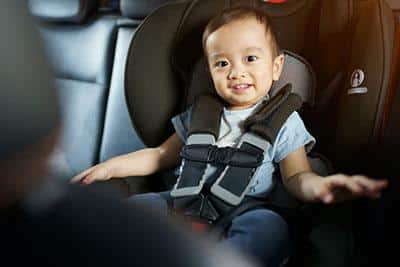The NHTSA, AAP, IIHS, and similar organizations are the most valuable sources for proper car seat use. Unfortunately, many parents tend to rely on different sources (other parents' experiences, stories, examples, etc.) and misuse the restraint system.
Here's the deal: it would be best to forget the car seat safety myths and focus on the approved use of the car seats.
So, whether or not you know the most prominent car seat safety myths, we will discuss the facts and misconceptions and show how to use child restraint systems adequately.
More...
Table of Contents
- Car Seat Myths & Facts: What Parents Need to Know?
- Myth #1: A child can be forward-facing after their first birthday
- Myth #2: A child must be in a forward-facing seat when their legs touch the back of the vehicle seat
- Myth #3: Using both lower anchors and vehicle seat belt is the safest option for car seat installation
- Myth #4: The LATCH system is safer than just a seat belt installation
- Myth #5: Using a top tether is optional
- Myth #6: A child is six years old, weighing 30 pounds, and they can transmit to booster seats
- Myth #7: An older child doesn't need a booster car seat
- Myth #8: A child can sit in the front seat when they turn twelve
- Myth #9: Used car seats will still keep a child safe
- Myth #10: More expensive car seats are safer than the cheaper models
- Final Thoughts
Car Seat Myths & Facts: What Parents Need to Know?
Below are some common car seat misconceptions that can cause severe injuries to your little ones. Let's explain each together.
Myth #1: A child can be forward-facing after their first birthday

The premise is wrong, according to experts. The safest method for children on the road is the rear-facing position. Kids should remain in the rear-facing car seat until their size and weight reach the upper weight limit recommended by the manufacturer (check the car seat manual).
Your children should be in the rear-facing seat until they're two or even older, as experts claim, and remain rear-facing as long as possible, as the AAP states.
The crash forces won't hurt your rear-facing children, as the Ohio University officials claim. The child's head, spinal cord, and neck remain intact as the rear-facing method keeps the impacts away and directs them along the frame. So, stick to the manual or follow the experts' advice to keep your babies safe. You can find more information here.
Myth #2: A child must be in a forward-facing seat when their legs touch the back of the vehicle seat
Child safety experts disagree with this claim. If your child's legs are over the rear-facing car seat, their safety is not compromised. A child's legs are often crossed or bent for a more comfortable position, and leg injuries are not expected.
The child's car seat will also move backward in a collision, creating more leg room. Child safety increases when they are within the upper weight and height limit, as the car seat was tested that way, preventing leg injuries.
Myth #3: Using both lower anchors and vehicle seat belt is the safest option for car seat installation
The safety experts suggest you follow the car seat manual instructions to see how to install car seats. Most manufacturers (Chicco, Graco, Britax, Safety 1st, etc.) allow only the seat belt or the LATCH installation, never a combination. The combination will apply too many crash forces and impact the child's car seat, increasing the risk of injuries. Of course, both installation types require restraints in the back seat of your vehicle.
Many car seats - more than 46% - are installed incorrectly, as the NHTSA's study shows. As a result, the car seat death rating is also high - more than 54%. So, refer to the manuals and contact your safety technicians to help with adequate installation.
Myth #4: The LATCH system is safer than just a seat belt installation
The claim is not valid, as both structures are equally safe. The LATCH system is only a quicker mode, as parents need to connect the car seat's anchors to the vehicle's anchors. You need to shake the child's car seat and ensure a tighter fit for correct use.
On the other hand, installing a car seat with a vehicle seat belt requires the correct placement of the seat belt retractor. In addition, you must lock the seat belt retractor to prevent the car seat's moving. Finally, whatever installation method you choose, you need to refer to the car seat manual and grab a seat near the belt path to see if it's still loosened or not. If the installation is tight, you're ready to go.
Myth #5: Using a top tether is optional
Applying a top tether anchor is never an optional choice; it's a must. You must permanently attach the car's anchor and the top tether strap when installing a forward-facing car seat.
Using the top tether reduces your child's neck and head movement by eight inches for safer riding and prevents further injury. Unfortunately, numerous caregivers remember to link the tether anchor to the car seat's connectors since the linker is often behind the car seat, out of sight.

Myth #6: A child is six years old, weighing 30 pounds, and they can transmit to booster seats
A booster seat uses a seat belt system as the primary restraint. The seat belt system is not as safe as the five-point harness. You should keep your kids in the harness as long as possible or until they outgrow the harness's maximum weight and height limit. Pay attention to the chest clip in the harness. It should be at the armpit level for proper use.
According to the NHTSA, your child must be at least four years old and 40 pounds to use a booster seat. Most children are not ready for boosters until they're much older (six, seven, or even eight), and they won't have adequate protection in boosters. If kids weigh less than the minimum weight recommendations, do not transit them in the booster seat.
Of course, kids won't have movement restrictions in boosters, but you must check if they can sit correctly in the car seat. If the kids move around while you're driving, keeping them in the five-point harness car seats is better.
Myth #7: An older child doesn't need a booster car seat
Older kids should remain in booster car seats until they are four feet nine inches tall. In addition, they must be at least eight years old, as the NHTSA states.
However, the recent studies run by the Children's Hospital Philadelphia have shown different results. For example, the adequately installed booster reduces serious injury for children aged four to eight by up to 45%. Unfortunately, this is not the case with seat belt-only use.
If seat belts are at your children's bellies rather than upper thighs and below the hip bones, the children can suffer a spinal injury or damage to internal organs in a car crash. So, the doctors recommend boosters to keep your children safe on the road. However, you won't need boosters when they properly use seat belts (straps cover their shoulders and upper thighs instead of neck and stomachs).
Myth #8: A child can sit in the front seat when they turn twelve
The NHTSA and most car seat manufacturers disagree with this statement. They state that children must be at least thirteen years old to sit in the vehicle's front seat.
Older children (thirteen plus ages) have already developed their bones and muscles, and they can withstand the pressure of the airbag system in a car crash, as the CHOP states. The pressure won't cause spine injuries, as the children can resist the impacts and will avoid deadly injuries.
In addition, children under thirteen must be correctly restrained in the car seats in the back seat of your vehicle. And, even if you must install a car seat in the front passenger seat for younger children, ensure you deactivate the airbag system. Find more information here.
Myth #9: Used car seats will still keep a child safe
The child passenger safety experts strongly deny this statement. Car seats have expiration dates on the label or on the car seat manual. Multiple car seats (Graco, Chicco, Britax, etc.) will last between six and ten years. It would help if you did not use them after the expiration date.
In addition, you don't know the history of the used seats. They might have been in the crash, and there's no visible damage, so no one can assure you the children will be 100% secure.
Suppose you still decide to use second-hand seats. In that case, you can check if the restraint meets the NHTSA safety checklist. Or you can contact a verified child passenger safety technician to inspect your seat. You could also find the inspection center near you (fire/police station, hospital, etc.) to verify the child safety in restraints.

Myth #10: More expensive car seats are safer than the cheaper models
The premise is incorrect, as all child restraint systems must pass the NHTSA safety tests to be used on the road. If the child restraints don't pass the crash tests and show lower results, the NHTSA will not approve them for broader use.
These factors have nothing to do with the price. For instance, you can place your child in a cheaper model for less than $300 or use a more expensive child seat. Both are perfectly fine, as long as they are crash-tested and the IIHS and NHTSA approve them.
The price question is only valid when choosing the child restraint's quality and material. For example, some units have more padding or breathable materials, others less, so they will or won't offer more comfort for your child. You can find the best models here.
Final Thoughts
Hopefully, you learned more about the car seat safety myths and found crucial facts to consider for proper car seat use. It would help to follow the official guidelines and stick to them.
Then, you will reduce the risk of severe injuries and keep your children safe on the road. Otherwise, you might compromise your children's security.
